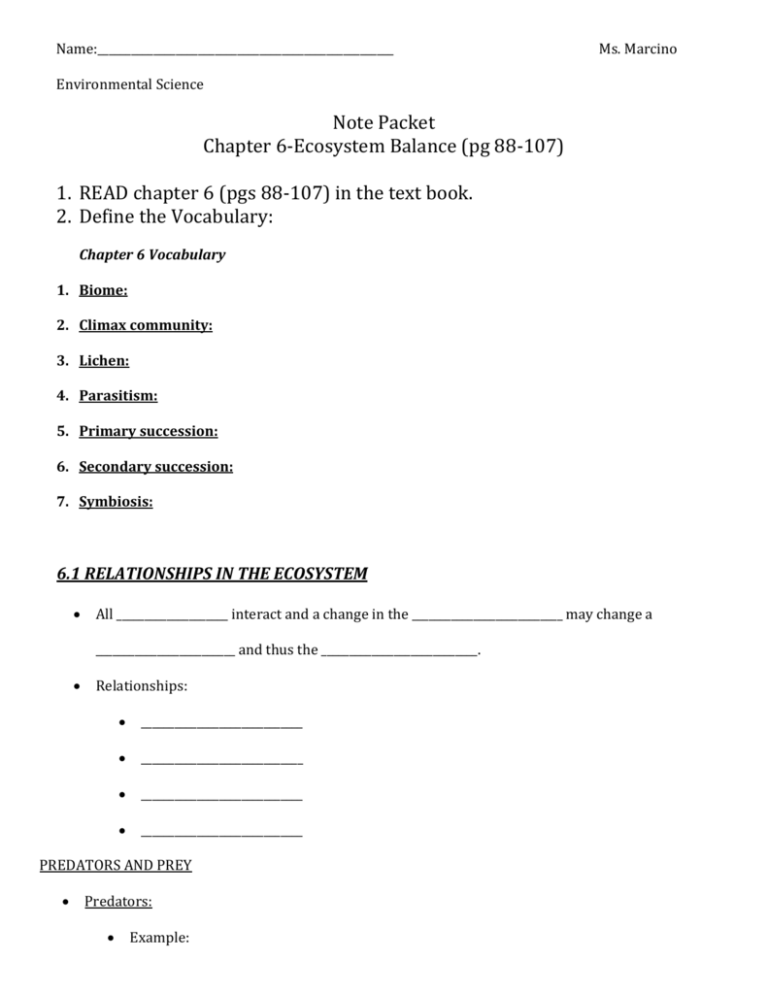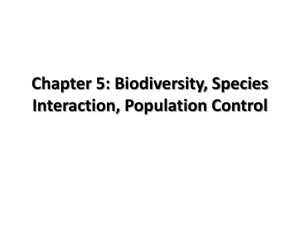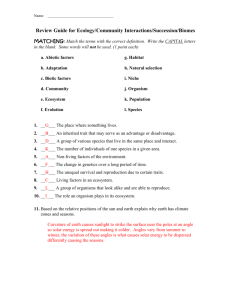6.1 relationships in the ecosystem
advertisement

Name:_____________________________________________________ Ms. Marcino Environmental Science Note Packet Chapter 6-Ecosystem Balance (pg 88-107) 1. READ chapter 6 (pgs 88-107) in the text book. 2. Define the Vocabulary: Chapter 6 Vocabulary 1. Biome: 2. Climax community: 3. Lichen: 4. Parasitism: 5. Primary succession: 6. Secondary succession: 7. Symbiosis: 6.1 RELATIONSHIPS IN THE ECOSYSTEM All ____________________ interact and a change in the ___________________________ may change a _________________________ and thus the ____________________________. Relationships: _____________________________ _____________________________ _____________________________ _____________________________ PREDATORS AND PREY Predators: Example: Prey: Example: The ______________ of both populations ____________________________________________________________________. Example: snowshoe hare and lynx Increases in the _________________________________________ increase the ______________________________. More _______________ (food) can _______________________________________________________________. A decreases in the ____________________________________________ leads to a __________________________ in the lynx population. PARASITISM Parasitism: Host: Parasites are __________________________________________________________________________________________________. Depends on the host _______________________________________________________________________________________. Examples: SYMBIOSIS Symbiosis: __________________________________-__________________________/____________________________________ Mutualism-___________________________________________________. __________________________________________-one benefit/______________________________________________. Commensalism: Example: Mutualism: Examples: CHECK FOR UNDERSTANDING: 1. What processes link the sizes of predator and prey populations? 2. Why are herbivores not considered to be parasites? 3. How are the 3 types of symbiosis different? How are they similar? 6.2 ECOLOGICAL SUCCESSION Ecological Succession: May take __________________________________________________________________________. Each new community makes it __________________ for the _____________________________________ to survive. Two main types: 1. _______________________________________________________ 2. _______________________________________________________ PRIMARY SUCCESSION Primary Succession: Occurs in __________________________________________________________________________________________. Steps: 1. -Lichen: -Pioneer community: 2. 3. 4. 5. -Climax community: SECONDARY SUCCESSION Secondary succession: Examples: Frequently disturbed habitats may _________________________________________________________________ Example: STEPS: 1. 2. 3. 4. AQUATIC SUCCESSION Starts with a _______________________________________ __________________________________________________________ Leads to a ____________________________________________________________________________________________________ ISLAND SUCCESSION Populations of new __________________________________________________________________________________________ or to form new species. CHECK FOR UNDERSTANDING: 1. How does primary succession differ from secondary succession? 2. What is a climax community? 3. Suppose humans put out all the fires in a large area of grassland over a period of 100 years. What would happen to the grassland community? 6.3 BALANCE IN THE ECOSYSTEM If ecosystems are not balanced, ____________________________________________________________________. __________________________________ are normal; they ___________________________________________ in the ecocsystem. Chaos Theory Suggests that ecosystems may be ______________________________________________________________. 6.4 LAND BIOMES We divide the ecosystems on Earth into ___________________________________________________________. Biome: Terrestrial (_____________________) biomes Type of biome depends on _____________________________________________________________________ _________________________________________________________________________________________. Aquatic (______________________) biomes Determined by ________________________________________________________________________________. 8 Major Terrestrial Biomes: 1. 2. 3. 4. 5. 6. 7. 8.








